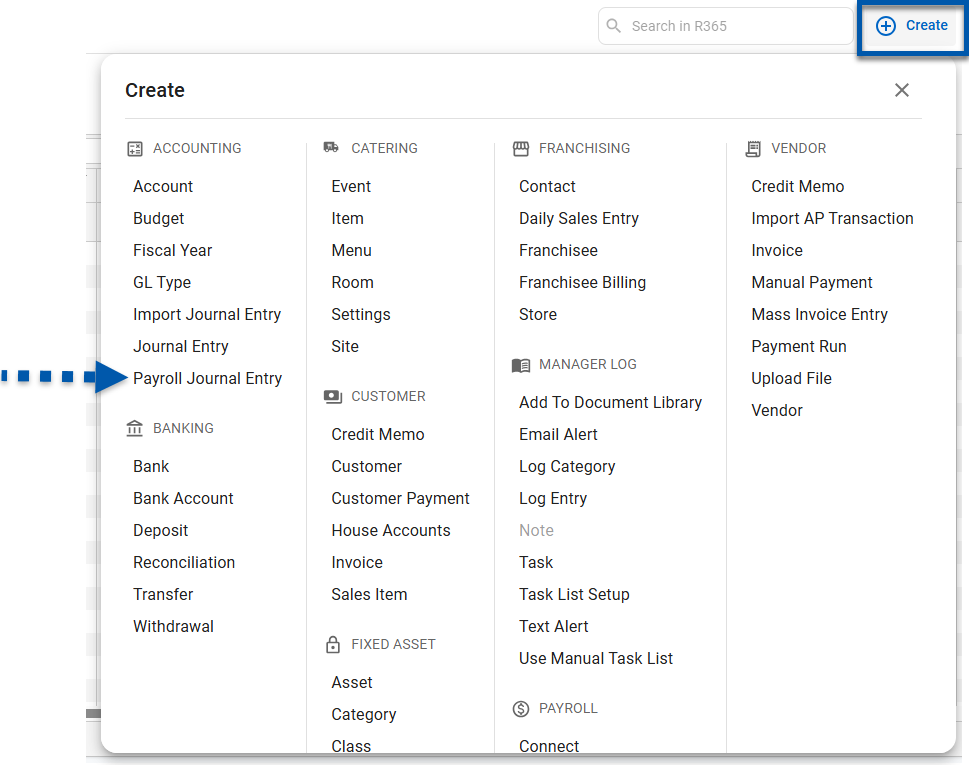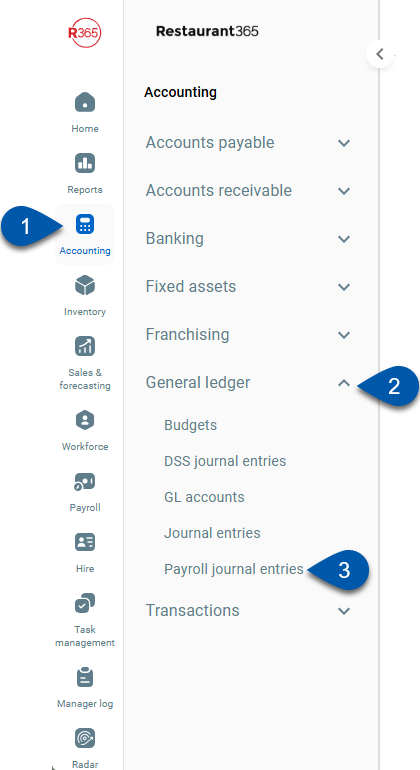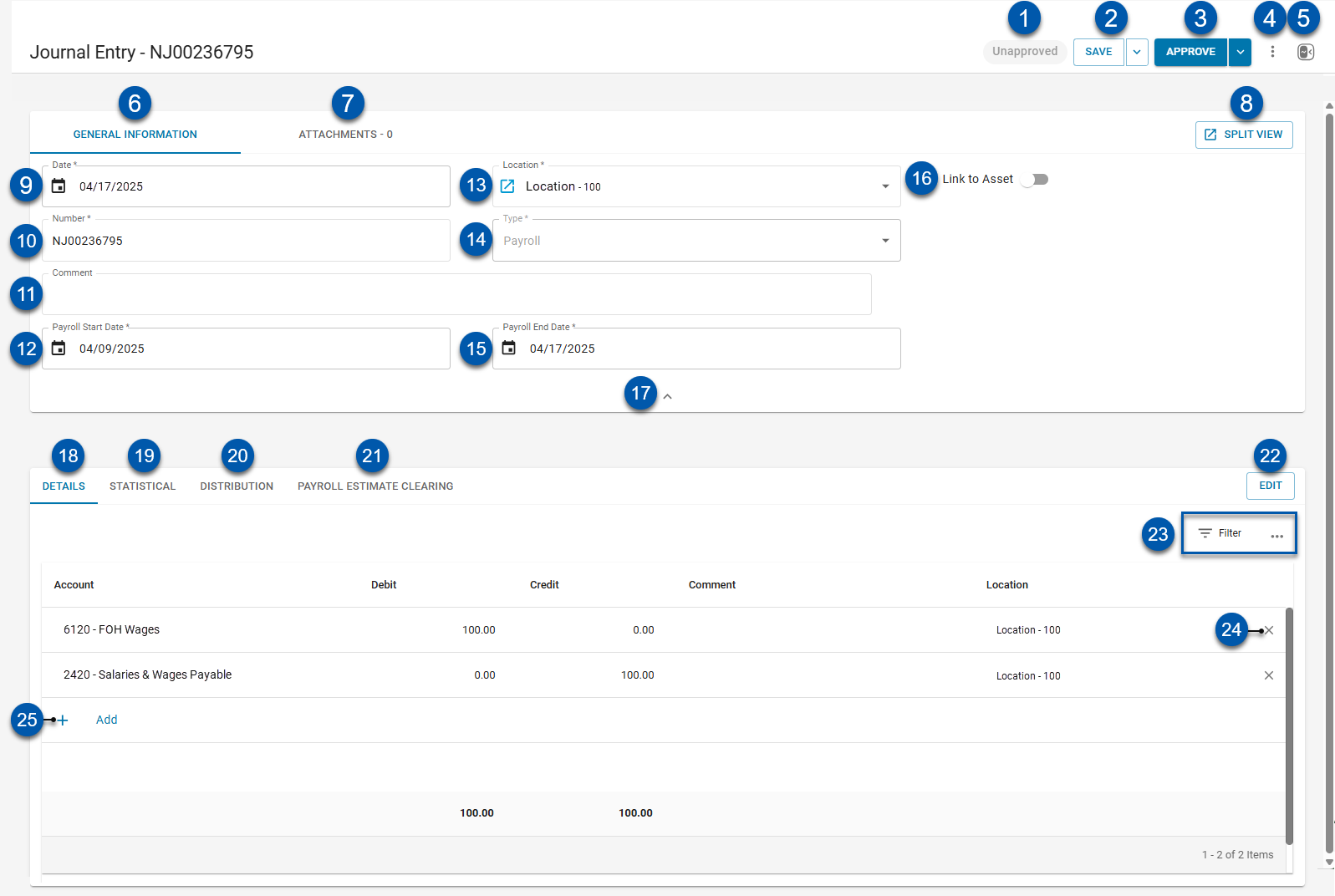Payroll journal entries record payroll-related financial transactions, including wages, taxes and deductions, within the general ledger. These entries reflect payroll data imported from a payroll provider or manually entered to align labor expenses with financial reporting. Payroll journal entries are used to reconcile labor accruals from POS data for each day of the pay period.
For organization accruing labor from POS imports, all Daily Sales Summaries (DSSs) from the pay period must be approved before the associated payroll Journal Entry is approved.
There are three unique fields on a payroll journal entry transaction that set it apart from a normal journal entry transaction:
Payroll Start Date - Records the start date for the pay period.
Payroll End Date - Records the end date for the pay period.
The Payroll Estimate Clearing tab - Displays the reversing entry of all the labor accrual entries.
From this page, users can:
Approve/Unapprove Payroll Journal Entries
Duplicate Payroll Journal Entries
This article references the new journal entry experience, which will be enabled for all customers in 2026.
At that time, the classic payroll journal entry experience will no longer be supported.
Security
The following Permissions are associated with payroll journal entries:
General Ledger → Payroll Journal Entries → View Payroll JEs
General Ledger → Payroll Journal Entries → Edit Payroll JEs
General Ledger → Payroll Journal Entries → Create Payroll JEs
General Ledger → Payroll Journal Entries → Approve Payroll JEs
General Ledger → Payroll Journal Entries → Unapprove Payroll JEs
These permissions can be added to custom user roles or individual users. The Permission Access report can be used to determine which user roles or users already have these permissions assigned. For more information, see User Setup and Security.
Navigation
To open a new journal entry:
Open the Create menu then select Payroll Journal Entry.

To view an existing payroll journal entry, navigate to the Payroll Journal Entries page:
Open the Accounting application.
Expand the General Ledger category.
Click Payroll Journal Entries.

Payroll Journal Entry
Buttons and Fields

Field | Description | |
|---|---|---|
1 | Transaction Status | Displays status information and references for the journal entry, including:
|
2 | Save | Provides the following options for saving the record:
|
3 | Approve/Unapprove | Provides the following options for approving the record:
Once the transaction has been approved, this button is replaced with an unapprove button. |
4 | Action | Opens a menu of the following options:
Once the payroll journal entry is saved, the following options are added to the menu:
|
5 | Show/Hide Activity | Opens or closes the activity feed for the transaction in a sidesheet, which displays a history of all actions performed on the payroll journal entry and allows users to add notes using the comment field. |
General Information | ||
6 | General Information Tab | Opens the general information tab. |
7 | Attachments Tab | Opens the attachment tab where files are uploaded and attached to the journal entry.
|
8 | Split View | Splits the screen to display the journal entry on the left side and the attachment on the right side. |
9 | Date | The date of the journal entry. Defaults to the current date.
|
10 | Number | A system-generated number used to identify the transaction.
|
11 | Comment | An optional field for comments about the journal entry. |
12 | Payroll Start Date | First date of the pay period. |
13 | Location | Location to which the payroll journal entry is assigned.
|
14 | Type |
|
15 | Payroll End Date | Last date of the pay period. |
16 | Link to Asset | When selected, items in the details section can be linked to assets. |
17 | Expand/Collapse | Collapses or expands the general information tab. |
Details | ||
18 | Details Tab | Opens the details tab where the debits and credits of the journal entry are entered. |
19 | Statistical Tab | Opens the statistical tab where statistical entries that do not impact the general ledger are entered. Only statistical GL accounts are available for selection in this tab. |
20 | Distribution | After selecting the Payroll Start Date and Payroll End Date and entering the full journal entry on the Details tab, use the Distribution tab to view the net effect of the payroll journal entry on the GL accounts. This differs from the total values entered on the Details tab because the system also creates a reversing entry for the labor accruals recorded during the period. The Distribution tab shows the net difference between the full payroll entry and the reversal of those accrual entries. If accrual percentages are accurate, the values on this tab should be relatively small. Larger-than-expected values may indicate that job titles are assigned to incorrect GL accounts.
|
21 | Payroll Estimate Clearing Tab | This tab displays the reversing entry of all labor accrual entries made by the POS integrations after the transaction is approved. Individual daily labor accrual entries are not lost. The payroll clearing entry makes a single reversing transaction on the date of the payroll journal entry for the sum total of all the accrual entries for the payroll period. |
22 | Edit/Edit Complete | Edit: Enables edit mode in the details section of the journal entry. Edit complete: Replaces the edit button in edit mode and applies the changes made to the journal entry.
|
23 | Table Options | Filter - Opens the Filter menu, where filters based on column values can be applied. When filters are applied, the number of conditions is displayed next to the button.
Menu - Contains the following additional table actions:
|
24 | X | Deletes the row. |
25 | Add | Adds a row to the details table. |
Columns
Button/Field | Description |
|---|---|
Account | The GL (general ledger account) for the debit/credit row. |
Debit | The debit amount for the selected GL Account. |
Credit | The credit amount for the selected GL account. |
Comment | The comment for the detail row. |
Location | The location for the detail row. |
Attachments Tab
Field | Description | |
|---|---|---|
1 | Split View | Splits the screen to display the journal entry on the left side and the attachment on the right side. |
2 | Document Link | Opens the View Attachment window where attachments can be previewed or downloaded. |
3 | Trashcan | Deletes the file from the transaction. |
4 | Upload | Opens a file selector window.b |

